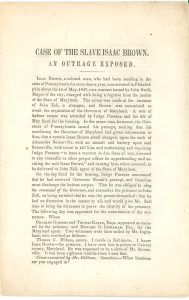Issac Brown, (aka Samuel Russell)
An Outrage! A real-life illustration of what life was like for a Calvert County enslaved person and the law..
(1794 – ?)

Alexander Somervell enslaved over thirty African Americans on his Lusby farm in Calvert County, Maryland including Issac Brown who lived there with his free wife, Susanna, and their eight children. On October 23, 1845, Somervell accused Issac of shooting him through an open window. Somervell didn’t see the shooter and there were no witnesses. Issac was three miles away at the time of the shooting, but a posse quickly captured him and locked him up in the Prince Frederick jail. Officials bound and tortured Issac for over 33 days with no evidence brought against him. Somervell (now fully recovered) sold Issac Brown to local slave traders.
The slave traders took Brown to Baltimore and sold him to Maryland’s largest slave trader, the notorious Hope Hull Slatter, who shipped him to Louisiana. In January 1846, William Butler Kenner purchased Brown to work on his large sugar cane plantation in Louisiana. Brown made a daring escape from Kenner’s plantation, travelling over 1200 miles through slave territory with the help of the Underground Railroad. Free Black people and anti-slavery allies guided and protected Issac on his journey. He arrived safely in Philadelphia in late 1846 going by the name of Samuel Russell.
Authorities discovered Brown’s location in April 1847, when a letter to his son was intercepted at the St. Leonard, Maryland Post Office. Maryland’s Governor immediately issued an order to Pennsylvania’s governor to arrest Brown and return him to Maryland. His case created an outcry among Philadelphia’s large free Black population and Anti-Slavery whites. Pennsylvania had just enacted a new Anti-Kidnapping Law designed to stop bounty hunters and “slavers” from kidnapping suspected freedom seekers.
When Brown’s attorneys secured his temporary release from jail, and legal maneuvers delayed his hearing, Samuel Russell and his family escaped on the Underground Railroad travelling six hundred miles to Canada. The Russell family settled near the town of Chatham, Ontario, where Issac (Dr. Samuel Russell) opened a botanic medicine shop and purchased a home. Although the Russell family struggled with financial hardship and racial prejudice, they were together, safe, and free.
Did You Know?
- The Underground Railroad was not an actual railroad but a network of mostly Free Black people, their allies, White abolitionists, and Indigenous people, who assisted freedom seekers to escape slavery.
- Railroad “conductors” assisted “passengers” with food, legal papers, clothing, and guided them to safe places as they moved out of slave territory.
- Historians estimate that 100,000 people were helped on the Underground Railroad between 1810 and 1850.
- Some Freedom seekers also went south to Mexico, to the Caribbean, and to Indian Country in the Western Territories.
Additional Resources
Case of the slave Isaac Brown : an outrage exposed. | Library of Congress (loc.gov)
American Memory, Slaves, and the Courts, 1740-1860, Case of the Slave Issac Brown. Library of Congress.
Baltimore Sun, May 5, 1847-May 26, 1847, State Law Library.
Maryland Republican, Nov 1, 1845, SC3655 MSA
One More River to Cross. By Bryan Prince. 2012. Book.
Prince, B. (2007). The case of Isaac Brown: fugitive slave. Ontario History, 99(1), 18–30. https://doi.org/10.7202/1065794a
Case of the slave Isaac Brown : a machine r
readable transcription. (loc.gov), Library of Congress
https://education.nationalgeographic.org/resource/underground-railroad/
https://www.history.com/topics/black-history/fugitive-slave-acts
_trail-of-souls-full-story.pdf (faithconnector.s3.amazonaws.
0e4716292_1449286693_continuing-on-the-trail-of-souls.pdf (faithconnector.s3.amazonaws.com)
Isaac Brown (buxtonmuseum.com)
